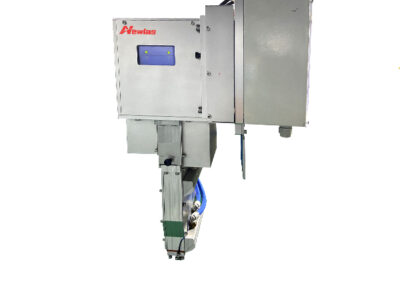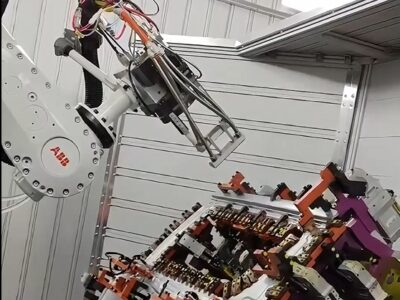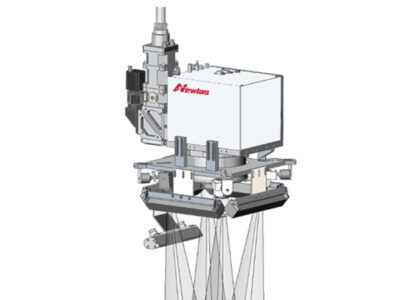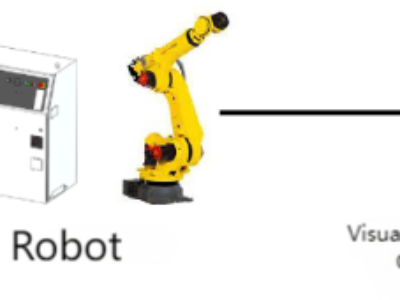1,Flying Welding
Laser flying welding integrates the advantages of remote welding, galvo mirrors, and robotic arms,complemented by professional graphic processing software, to achieve three-dimensional spatial instantaneous multi-track welding.
Main applications: automotive body, seats, and common automotive accessories, materials can include various steel grades, cold-rolled sheets, aluminum alloys, and other common materials, as well as composites, such as magnesium-aluminum alloys.
Seat Flying Welding
**Advantages:**
– Any weld pattern
– Any weld direction
– User-defined weld/point distribution
– Optimized stress distribution
– Enables high-speed spot welding, seam welding, lap welding, butt welding, fillet welding, and lap joint welding
– Real-time synchronization of the welding head and robot, accelerating the laser welding process.
– Requires less floor space
– Lower maintenance and logistics costs

2,Helical Welding
A laser welding method with a double wedge shape, achieved by configuring a special wobble module on the welding head to create a helical pattern in the weld bead as the focusing spot moves.
Mainly used for hinge welding, heat exchangers, tubular heat exchangers, thick pipe welding for oil and natural gas, flange welding, and aluminum alloy welding.
**Advantages:**
– Weld bead widening
– Extremely high processing repeatability/process stability
– Better weld bead formation
– Simpler post-processing, resulting in a smoother surface on the welded workpiece
– Excellent aluminum alloy welding capability
3,Laser Brazing
Laser brazing involves using a filler metal with a lower melting point than the parent material to bond parts by melting the filler and allowing it to wet the parent materials and fill the joint gap,diffusing and bonding the parts together. Mainly applied to aluminum body frame structures, such as the connection of the top panel and the side panels, and door components.
**Advantages:**
– Reduces pure laser welding defects such as porosity, cracks, and excessive joint clearance
– Increases weld strength and achieves a more perfect weld bead
-The parent material does not melt in brazing, only the filler melts
– Low brazing distortion, smooth and aesthetically pleasing joints, suitable for welding precision,complex, and structurally diverse components
– Small heat-affected zone, high compressive strength

4,Laser Filler Wire Welding
Laser filler welding uses a filler metal the same or similar to the parent material, which is melted along with the parent material to form the weld joint. Mainly applied to the entire vehicle’s structural parts and automotive accessories.
**Advantages:**
– Reduces pure laser welding defects such as porosity and cracks
– Increases weld product quality, allowing for slightly larger weld clearances
– The welded parent material melts, resulting in a stronger weld than the parent material
5,Oscillating Brazing
Through Newlas—FA3, the functionalities of beam shaping and weld seam tracking are integrated into a single device. The filler wire can act as a mechanical sensor. Mainly used for white body laser welding, including laser brazing of the car roof and trunk lid, and brazing of automotive components such as door parts. The vibration and fixture errors of parts often make laser brazing very challenging, leading to difficult welding process adjustments, but oscillating brazing can effectively adjust its welding direction, and the functions of weld seam tracking and automatic focus compensation make it easy to direct and focus the laser beam, achieving multi-directional changes.It has high automation, fast welding speed, and high efficiency, ensuring good welding quality.
**Advantages:**
– Weld seam tracking and real-time determination of part seam trajectory
– XYZ three-directional adaptive adjustment of the welding trajectory according to different part deviations, achieving good welding quality
– Improve product weld consistency
6,Annular Spot Brazing
By incorporating a dual spot module into the lens, the welding process utilizes a three-spot module in brazing optics to distribute a single beam into three beams, providing a solution for brazing hot-dip galvanized steel. This results in smoother welds that do not crack. It is mainly applied to aluminum alloy brazing of white bodies, laser brazing of car roofs and trunk lids, and brazing ofautomotive components.
**Advantages:**
– A more stable and reliable brazing process
– Faster speed
– Higher strength
– Higher surface quality for hot-dip galvanized plate welding
– Online cleaning process
– Dynamic energy adjustment
7,Multi-wavelength Composite Welding
Multi-wavelength composite welding involves overlaying two laser beams of different wavelengths to align the axes of both beams in space, with the main wavelength laser focusing on welding and the secondary wavelength laser preheating the filler wire and parent material to reduce the cooling rate of the molten metal pool. It is particularly suitable for Aluminum alloy, magnesium alloys, and copperalloys.
Composite Welding Beam
**Advantages:**
– Reduces porosity content
– Increases the stability and efficiency of welding beads
– Effectively relieves thermal stress, reducing cracks and improving weld strength for a more
uniform appearance
**Summary:**
Currently, in the laser welding industry, Newlas technology and equipment are leading the pack.From optical processing heads to power meters, in-process monitoring, post-weld inspection, and TCP calibrators, the entire range of auxiliary equipment is independently developed and patented. Other domestic enterprises are making a full effort to catch up.
Author:Mac
mengxiaojun@newlas.com













